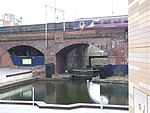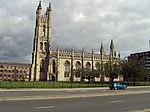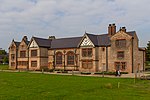Cornbrook tram stop

Cornbrook tram stop is a tram stop on Greater Manchester's light rail Metrolink system in the Cornbrook area of Manchester, England. It is an interchange station, allowing passenger transfer between the network's Altrincham, Eccles, Airport, Trafford Park and South Manchester lines. The station opened on 6 December 1999 for line transfers and allowed street-level entry and exit to the public from 3 September 2005. It takes its name from Cornbrook Road, between the A56 and Pomona Docks on the Manchester Ship Canal, and was built on what was a Cheshire Lines Committee route to Manchester Central railway station. The stop is one of the most used on the Metrolink network.
Excerpt from the Wikipedia article Cornbrook tram stop (License: CC BY-SA 3.0, Authors, Images).Cornbrook tram stop
Dinton Street, Manchester Hulme
Geographical coordinates (GPS) Address Nearby Places Show on map
Geographical coordinates (GPS)
| Latitude | Longitude |
|---|---|
| N 53.47 ° | E -2.2675 ° |
Address
Cornbrook
Dinton Street
M15 4LW Manchester, Hulme
England, United Kingdom
Open on Google Maps







